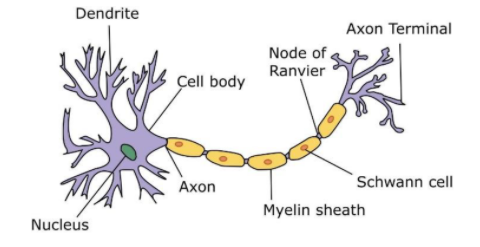
Describe briefly the structure of the nerve cell.
Answer
495.9k+ views
Hint: A nerve cell is the elementary functional unit of the nervous system. It is also known as a neuron. It is composed of a cell body that possesses a nucleus and remaining cell organelles like mitochondria, endoplasmic reticulum, Golgi apparatus. It contains tiny branches called dendrites all over the cell body.
Complete answer:
Nerve cells may be designated as receivers and transmitters of information that permit an organism to respond properly. Neuron’s dendrites accept signals from other cells and transfer them toward the cell body. Axon is the sole long output from the cell body.
It carries data from the cell body over long distances rapidly. The Axon terminal is located at the end of the axons. It makes the real connection to other neurons. In a few nerve cells, axons are encompassed by a myelin sheath. It acts as protection for the axon. The spaces between myelin sheath cells are called Nodes of Ranvier. The Schwann cell plays a significant role in myelinating the axons of the PNS.

Additional information:
For most of the neurons, nerve impulses originate when the membrane potential of the neuron is adequately depolarized and reaches a definite threshold. This permits some of the neurons to start impulses and hence information to specific targets.
Note: Neurons come into interaction with other cells at sites called synapses. This is the site at which the nerve endings of the cells come in contact letting for positive communication.
In such a case, neurons play an accessible function by getting information that is initiated from the stimuli. It is this receptive function of the neurons that guarantees the operative transmission of information and therefore the suitable response to stimuli.
Complete answer:
Nerve cells may be designated as receivers and transmitters of information that permit an organism to respond properly. Neuron’s dendrites accept signals from other cells and transfer them toward the cell body. Axon is the sole long output from the cell body.
It carries data from the cell body over long distances rapidly. The Axon terminal is located at the end of the axons. It makes the real connection to other neurons. In a few nerve cells, axons are encompassed by a myelin sheath. It acts as protection for the axon. The spaces between myelin sheath cells are called Nodes of Ranvier. The Schwann cell plays a significant role in myelinating the axons of the PNS.

Additional information:
For most of the neurons, nerve impulses originate when the membrane potential of the neuron is adequately depolarized and reaches a definite threshold. This permits some of the neurons to start impulses and hence information to specific targets.
Note: Neurons come into interaction with other cells at sites called synapses. This is the site at which the nerve endings of the cells come in contact letting for positive communication.
In such a case, neurons play an accessible function by getting information that is initiated from the stimuli. It is this receptive function of the neurons that guarantees the operative transmission of information and therefore the suitable response to stimuli.
Recently Updated Pages
Master Class 9 General Knowledge: Engaging Questions & Answers for Success

Master Class 9 English: Engaging Questions & Answers for Success

Master Class 9 Science: Engaging Questions & Answers for Success

Master Class 9 Social Science: Engaging Questions & Answers for Success

Master Class 9 Maths: Engaging Questions & Answers for Success

Class 9 Question and Answer - Your Ultimate Solutions Guide

Trending doubts
State and prove Bernoullis theorem class 11 physics CBSE

What are Quantum numbers Explain the quantum number class 11 chemistry CBSE

Who built the Grand Trunk Road AChandragupta Maurya class 11 social science CBSE

1 ton equals to A 100 kg B 1000 kg C 10 kg D 10000 class 11 physics CBSE

State the laws of reflection of light

One Metric ton is equal to kg A 10000 B 1000 C 100 class 11 physics CBSE




